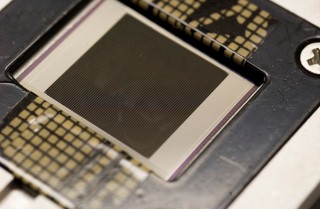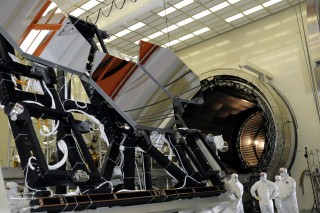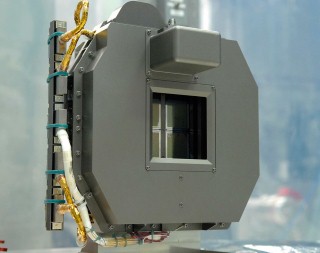Microshutters: The James Webb Space Telescope's (JWST) Near-infrared Spectrograph will use microshutters that act like tiny doorways to block unwanted light from nearby objects in space, while allowing light from very distant stars and galaxies to shine through. The microshutters are assembled as an array about the size of a postage stamp. Each array contains over 62,000 shutters. Individually, each microshutter measures 100 by 200 microns, or about the width of a human hair. The telescope will contain four of these microshutter arrays.
Credit: NASA/Chris Gunn
I started my career working on experiments in the infrared, and today I’m at it again, working on the James Webb Space Telescope (JWST) mission. The JWST telescope will have a near infrared camera, a mid-infrared instrument that includes both a camera and a spectrograph, and a near infrared spectrograph for doing spectroscopy of extremely distant, very old, and very dim galaxies. These are galaxies from a time when the Universe was only a few hundred million years old. (The total age if the Universe is now considered to be 13.7 billion years.)
John Mather is the senior project scientist for the JWST, so we’re working together again. When the project was starting up, he said to me, “See if you can think of a way to do the spectroscopy for these distant galaxies.” And I said, “Well, okay, I’ll try.” We figured out that we needed to be able to open up a slit on each galaxy and block the light from the others, and we came up with a micro-shutter array. It’s really an amazing new technology. Microshutters “see” a dim object by selectively blocking out brighter sources of light in the cosmos. Each array of microshutters is about the size of a postage stamp arranged in a waffle-like grid. But each of these tiny square arrays contains 62,000 shutters that will function like tiny doorways, focusing the attention of the infrared camera on specific targets to the exclusion of others.
To get a good image of these very distant galaxies, it’s going to take about 100,000 seconds of exposure time, which is a little over a day for a single galaxy. The advantage of the microshutter array is that it will let us look at 100 of these distant galaxies all at once. So the difference between looking at them one at a time compared to 100 at a time means we'll speed up the science goals of the program by about a factor of 100.
James Webb Telescope Mirrors: The JWST will have a large mirror, 6.5 meters (21.3 feet) in diameter. The mirror is being built in segments and will be mounted on a structure that will fold up to fit into a rocket. The mirror will then unfold after launch. In this picture, a team of engineers and technicians from NASA and Ball Aerospace prepare to load three of the JWST mirror segments into a test chamber at NASA’s Marshall Space Flight Center in Huntsville, Alabama. There, they will subject the segments to temperatures reaching minus 414 degrees Fahrenheit -- ensuring the mirror segments can withstand the extreme temperatures of space.
Credit: NASA/MSFC/David Higginbotham/Emmett Given
JWST Near-Infrared Spectrograph (NIRSpec): Many of the objects that JWST will study, such as the first galaxies to form after the Big Bang, are so faint, that its giant mirror must stare at them for hundreds of hours in order to collect enough light to form a spectrum. In order to study thousands of galaxies during its 5 year mission, the NIRSpec is designed to observe 100 objects simultaneously. The NIRSpec will be the first spectrograph in space that has this multi-object capability.
Credit: Astrium/NIRSpec




